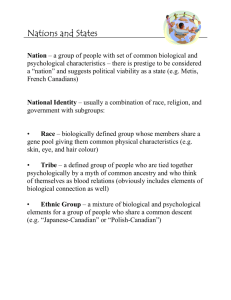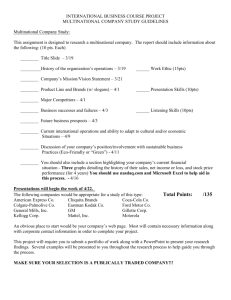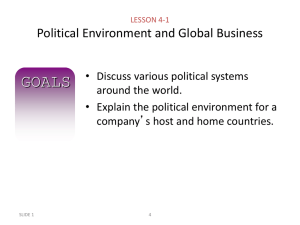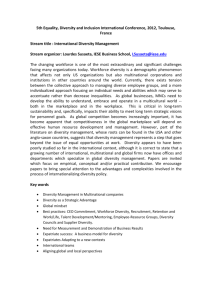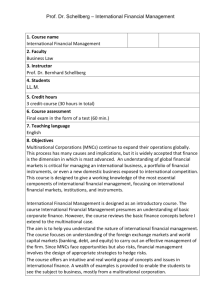from multinational to global companies
advertisement
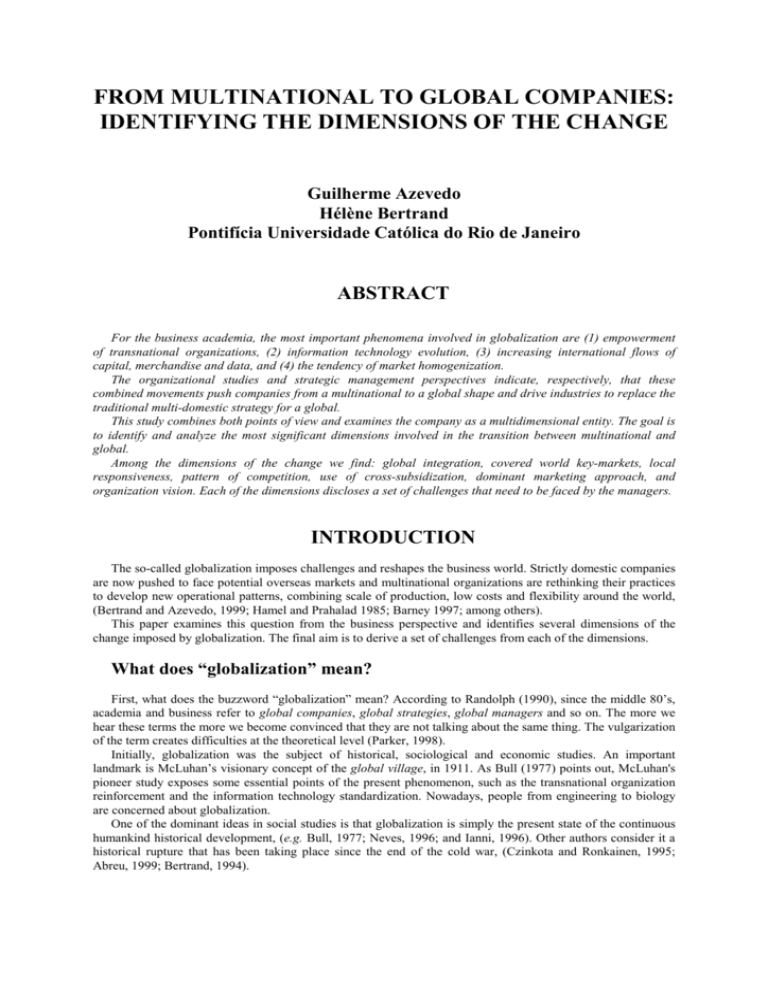
FROM MULTINATIONAL TO GLOBAL COMPANIES: IDENTIFYING THE DIMENSIONS OF THE CHANGE Guilherme Azevedo Hélène Bertrand Pontifícia Universidade Católica do Rio de Janeiro ABSTRACT For the business academia, the most important phenomena involved in globalization are (1) empowerment of transnational organizations, (2) information technology evolution, (3) increasing international flows of capital, merchandise and data, and (4) the tendency of market homogenization. The organizational studies and strategic management perspectives indicate, respectively, that these combined movements push companies from a multinational to a global shape and drive industries to replace the traditional multi-domestic strategy for a global. This study combines both points of view and examines the company as a multidimensional entity. The goal is to identify and analyze the most significant dimensions involved in the transition between multinational and global. Among the dimensions of the change we find: global integration, covered world key-markets, local responsiveness, pattern of competition, use of cross-subsidization, dominant marketing approach, and organization vision. Each of the dimensions discloses a set of challenges that need to be faced by the managers. INTRODUCTION The so-called globalization imposes challenges and reshapes the business world. Strictly domestic companies are now pushed to face potential overseas markets and multinational organizations are rethinking their practices to develop new operational patterns, combining scale of production, low costs and flexibility around the world, (Bertrand and Azevedo, 1999; Hamel and Prahalad 1985; Barney 1997; among others). This paper examines this question from the business perspective and identifies several dimensions of the change imposed by globalization. The final aim is to derive a set of challenges from each of the dimensions. What does “globalization” mean? First, what does the buzzword “globalization” mean? According to Randolph (1990), since the middle 80’s, academia and business refer to global companies, global strategies, global managers and so on. The more we hear these terms the more we become convinced that they are not talking about the same thing. The vulgarization of the term creates difficulties at the theoretical level (Parker, 1998). Initially, globalization was the subject of historical, sociological and economic studies. An important landmark is McLuhan’s visionary concept of the global village, in 1911. As Bull (1977) points out, McLuhan's pioneer study exposes some essential points of the present phenomenon, such as the transnational organization reinforcement and the information technology standardization. Nowadays, people from engineering to biology are concerned about globalization. One of the dominant ideas in social studies is that globalization is simply the present state of the continuous humankind historical development, (e.g. Bull, 1977; Neves, 1996; and Ianni, 1996). Other authors consider it a historical rupture that has been taking place since the end of the cold war, (Czinkota and Ronkainen, 1995; Abreu, 1999; Bertrand, 1994). Czinkota and Ronkainen (1995) explain that until the end of the "Soviet Empire" the world ideological division between East and West blocked the globalization process. From the point of view of some scholars in economic-politics, globalization is the result of the capitalism dominance (e.g. Banas, 1996; Ianni, 1996). Ianni reinforces this idea saying that it is a new capitalism cycle where production has become transnational. To other authors, globalization is related to the obsolescence of the nation-state system (Ohmae, 1995; Levitt, 1983; Furtado 1998). Ohmae (1995) proposes that the more natural model is the "region-state", an economic area defined independently of the national borders. Though there are still other relevant definitions from other fields, in this paper we only consider the business point of view. Based on Levitt (1983), Yip (1995), Bartlett and Ghoshal (1989), Hout et all.(1982), Campbell (1993), Keegan (1995), Bertrand (1994), Parker (1998), among others, the following definition emerges: Globalization is the set of transformations faced by companies as a consequence of the contemporary phenomenon constituted by: (1) the empowerment of transnational organizations; (2) the information technology evolution; (3) the increasing flows of capital, merchandise, and data across national borders; and (4) the tendency of world market homogenization. These new simultaneous transformations conduct the organizations to an unfamiliar future. There is also a new rhythm. The humankind has never produced knowledge so quickly and the world has never seemed to be so small. Organizations must be prepared to navigate across this unknown sea. This exploratory study can help managers and scholars to better understand the nature of the transformations. Global companies — the mainstream routes of investigation When we study global companies, we basically identify two mainstream routes of investigation. Some authors, as Bartlett and Ghoshal (1989), highlight structural aspects of the organizations. They analyze how global companies are, or should be. This organizational oriented analysis implies in defining ranges of different types of international companies according to their internal characteristics. The basic idea is to look inside the organization to see if it is a global company or any other type of international company. The second mainstream of investigation, which is closer to the logic of strategic management, considers the patterns of competition and market characteristics to identify a global industry, (Yip, 1995; Hoult et all., 1982; among others). In this case, a global company has no meaning because competitive strategies may be global; the companies are merely reshaped by the competitive forces. Campbell (1993) separates these two approaches when he states that globalization alters relations in intrafirms as well as in extra-firms. Changes in intra-firm relations are basically organizational and can be the result of new information technology or more productive plants. The extra-firm relations are modified by changes in global market segments or by the nature of the competition. What Campbell presents is an elegant solution to avoid answering what comes first, the global company or the global competition. Here, we will also avoid this question. In this study, it is only relevant to build a parallel between the two points of view. If we take the perspective of organizational studies, “multinational companies” are being transformed in “global companies” (Bartlett and Ghoshal, 1989; Ghoshal and Nohria, 1993; Keegan, 1995; among others). If we take the perspective of the nature of the competition, there is a consensus among authors that the strategy is changing from multi-domestic (or multinational) to global (Randolph, 1990; Yip, 1995; Hoult et all., 1982; among others). The transition from multinational to global company and the transition from multi-domestic to global strategy are the focuses of the present study. The central question is this combination of movements that we, from here on, simply refer to as transition from multinational to global. Furthermore, this paper adopts a new approach to the question by emphasizing the dynamics of the transformation. According to the literature review, existing studies typically analyze the multinational and the global company (or strategy) as static entities, independently of the perspective. The dynamic aspects of the transition are usually neglected. Next, we analyze the two states, multinational and global, to approach later, the dynamics of the transformation. Multinational and global states The literature defines the two states in different ways. Our starting point are "the classic" definitions of Bartlett and Ghoshal (1989). According to them, a multinational organization is a decentralized federation with distributed resources and delegated responsibilities that allows the foreign operations to answer to the local differences. A global organization is a centralized hub, a structural configuration based on group-oriented behavior requiring intensive communication and complex system of personal interdependencies and commitments. Actuallty, Bartlett and Ghoshal (1989) consider two different dimensions to classify international organizations: local responsiveness and global integration importance. They base their classification on organizational aspects of the company. Other authors, as already mentioned, prefer to center their classification on the structure of the competition or in the adopted approach of marketing. Boone and Kurtz (1998), for instance, recognize the difference between strategies of multinational marketing and global strategies but does not differentiate the company itself. Hout et all. (1982) connect the modification of the shape of the company with the type of competition of its industries. They call the strategic approach of multinational companies multi-domestic. Indeed, taking Yip’s (1995) perspective, the use of the term multi-domestic is more appropriate than multinational to describe a marketing action, as opposed to global. To Yip (1995), multi-domestic and global approaches can coexist in a temporary situation, and companies can take both forms of action, simultaneously. Boone and Kurtz (1998) corroborate this view. For them, global marketing applies the same marketing mix with minimum variations across the markets a company reaches, while the multi-domestic marketing represents a segmentation where specific national markets are identified and different marketing mixes set up. Keegan (1995) refers to Bartlett and Ghoshal’s (1989) work and focuses on the type of marketing reduzing the to five categories: domestic marketing, export marketing, international marketing, multinational marketing, and global/transnational marketing. The multinational marketing, as understood by Boone and Kurtz (1998), aims at customizing the knowledge and products for the diverse markets. It perceives the differences and the specific circumstances of each market, and adapts the marketing mix for them. The result is managerial decentralization, or, to use Barlett and Ghoshal’s (1989) typology, low level of global integration. On the other hand, the global/transnational marketing seeks to identify what is the universal culture and what is restrict to each market. The aim is to penetrate in multiple places with minimally customized marketing mix. The marketing actions are centralized (high global integration). Boone and Kurtz (1998) alerts that many companies practice multi-domestic marketing for having simply inherited decentralized structures of international marketing. Please note here that these authors, who do not have the organizational orientation, understand that the global perspective demands structural modifications in the company and not the contrary, i.e., first comes the strategic perspective and then the company shape. Another approach adopted by several authors is that the market is still sovereign to indicate when a multidomestic perspective can be substituted by a global. Ohmae (1985) identified a group of 600 million consumers emerging in the triad USA, Europe and Southeast Asia that can be considered, for marketing effect, as an single market with the same habits of consumption. The sprouting thriving of this mega-market allows the practice of global marketing. To Hamel and Prahalad (1985), a multinational approach occurs when a company is obliged to address each market separately. Only an international market that accepts standardized products will allow the use of global strategies. The literature also indicates that organization vision establishes the difference between multinational and global companies. Parker (1998), in her bibliographical survey, demonstrates that a typical feature of the global company is to have the world as home (vision that exceeds the internal and external borders of the countries). For Bertrand (1994), this means replace the ethnocentric vision of the organization for a polycentric one (or, according to the up-to-date terminology, geocentric). The objective is to become citizen of the world instead of national citizen. Having an ethnocentric vision means to observe the world with domestic references only, as domestic companies do. In the same way, the multinational company tends to adopt a polycentric vision, i.e., observe the world with different domestic references. The geocentric vision (to have the world as reference) is typically attributed to global companies. Parker’s (1998) world as home also refers to a worldwide presence. This point is clearly stated by Porter (1990). The global company has a global presence, i.e. it is present in all the key-markets of the world. Porter (1990) also refers to the activities that are integrated through the national borders. Hamel and Prahalad (1989) complement this idea emphasizing the importance of the integration of the production and distribution systems to global companies. In that view, a global company must necessarily make use of a system of distribution in order to reach all the world key-markets. Further developing the discussion about the production system, Barlett and Ghoshal (1992) note that the global company takes profit of the competitive advantages of the different regions of the globe. The global company seeks to use the best and cheapest resources available in different areas. To Yip (1995), the result is the creation of a global value-chain. Activities as research and development, design, buying, manufacture, assemblage, marketing, sales, distribution and services, are distributed around the world. This global value-chain represents what Barlett and Ghoshal (1992) call global integration. That means not simply centralize the management, but also design flexible production and distribution units that can be relocated. Investment and subsidy polices are also important points that refer to global integration. Hamel and Prahalad (1989) understand that the global distribution system allows the companies to cross-subsidy the markets. A previous work by Hout et al. (1982) identify that to compete globally the company must be prepared to, among others things: carry out great investments with null or even negative ROI; envision diverse financial objectives according to the market and keep product lines deliberately sub-priced in some markets. These unconventional management practices represent forms of cross-subsidy, which are typical of global organizations. For Andersen et all. (1997) to become a global company means to face the barriers of management mentality. There are relevant difficulties in the gradual development of an international ability. Abreu (1999) states that globalization, instead of companies, impacts people and the process of decision-making the most. Once existing understandings of multinational and global companies have been stated, we can now propose our definitions for the initial and the final states of the transition: Initial state (multinational company and multi-domestic strategy) -- Decentralized group of independent operations that focuses on some specific markets. It responds to local differences by adapting the marketing-mix. The competition takes place at a multinational environment. The limits of the national borders are respected. The marketing approach is multi-domestic and the organizational vision is polycentric. Final state (global company and strategy) -- Centralized group of integrated operations that are present in all the world key-markets. It searches to trespass the national borders, establishing global strategies and using high-standardized marketing-mix. The competition, as well as the marketing approach, is global with the presence of cross-subsidy. The organizational vision is geocentric. METHOD The transition from multinational to global was analyzed using a logical principle: comparison. Considering a given transformation, if we know the initial state of the object and its final state, we can compare them and find the minimal amount of change suffered during the transformation. To give an example, suppose the studied object is a sphere described by three dimensions: diameter, color and weight. If in the first state it is represented by (4 inches, blue, 4 pounds) and in the final state by (6 inches, red, 3 pounds), then we can infer that the transformation consisted of, at list, increase in diameter of 2 inches, change of color from blue and to red, and reduction in weight of 1 pound. In this study the initial and the final states, multinational and global, were determined by our reviewing the literature and the comparison of several definitions that gave origin to our definition of the two states (see the end of the introduction). The dimensions of the change presented in the results section were found by contrasting the two states we defined. RESULTS AND DISCUSSION The dimensions of the change The contrast between the initial and the final state determined the dimensions summarized in Table 1. The definitions of the two states indicated the values of the dimensions. Table 1 – Dimensions of the change and values Dimension 1. Level of global integration 2. Number of world key-markets covered 3. Local responsiveness 4. Dominant pattern of competition 5. Intensity of cross-subsidy 6. Dominant marketing approach 7. Type of vision Initial State Value Low Some High Multinational Low Multi-domestic Polycentric Final State Value High All Low Global High Global Geocentric To make these results more understandable, we regrouped them. The analysis of the nature of the dimensions showed that they are all, in some degree, interconnected. Because we look for a parsimonious model, which includes the smallest possible set of dimensions preserving the explanatory power, some of them can be merged. Dimension 5 (cross-subsidy) is part of dimension 4 (pattern of competition). Cross-subsidy is part of the global pattern of competition (Hout et all., 1982; Hamel and Prahalad, 1989). Therefore, dimension 5 can be deleted. Dimension 3, local responsiveness, can be seen as a function of dimension 6, dominant marketing approach. Companies that adopt a multi-domestic marketing approach, as understood by Boone and Kurtz (1998), are more able to respond locally. A multi-domestic marketing implies customizing the marketing-mix for each market. A company that focuses on a specific market, tailoring an operation to it, will respond better to local demands than a than a company that expects to use the same operation in several markets. Therefore, dimensions 3 and 6 were merged. Table 2 indicates these considerations. Table 2 – Regrouped dimensions of the change and values Dimension 1. Level of global integration 2. Number of world key-markets covered 3. Dominant pattern of competition 4. Dominant marketing approach 5. Type of vision Initial State Value Low Some Multinational Multi-domestic Polycentric Final State Value High All Global Global Geocentric Next, we present a discussion about the challenges faced by the organizations in face of each of the dimensions of the change presented in the results. Challenges imposed by global integration The transition from multinational to global represents a change from a low to a high level of global integration. Global integration means centralized management and integrated operations. Lack of uniformity, operational redundancies, and diversity of the multi-domestic cultures are barriers to global integration. To overcome the fragmented structure, the company should unify operations and eliminate repetitions. Culture may also represent difficulties to this integration. People from the several operations of the multinationals are not used to comprehending theirs companies as a whole and horizontal communication across different operations is usually very low. We are not talking about unifying the culture of the several units, but about making them compatible and creating a minimal common code. A special problem concerns developing common code when multinational companies merged. Independent operations placed in multiple locations represent cost repetition and, secondarily, useless internal competition. The organization should be reshaped, a global value chain should be developed, which means unifying the several parts of production and distribution and placing them in the most favorable locations. Global integration will demand development of the communication system. The information technology should be used in order to transform the set of national operations into a single global operation constituted by interconnected parts that are located in the different areas. Challenges imposed by key-markets coverage Covering all the world key-markets usually implies expansion. As demonstrated, multinational companies tend to cover some key-markets only, and global companies aim to cover them all. This expansion can be an enormous obstacle. Possibly, companies that do not have critical mass to reach the diverse markets and that are not capitalized for such will be obliged to opt between merging with other companies, being sold to other companies, or creating joint-ventures in uncovered markets. If the company has capital, or access to it, shortcuts can be used (basically acquisition of companies, operations, brands or technology in other markets). Presence in all the key-markets can be understood as more than being at all the main consumer markets. A company that competes globally should also assure its presence in the diverse centers of production and origin of raw materials and parts, for instance. This means that wide market coverage demands a global value chain, as it happens in global integration. Challenges imposed by global competition Global competition implies increasing flows of capital, information, and merchandises across the operations, which should constitute a global value chain. The logistics of production, marketing, and distribution are indispensable to create a global network that creates the interdependence that will allow the exploitation of worldwide competitive advantages. Obtaining the competencies to create this network is an important challenge. The capital stream may allow the group expansion. Cross-subsidy is usually necessary to compete globally. The results of the diverse operations cannot be analyzed separately and a mentality of change is necessary. To move to the patterns of global competition, a company should develop managerial mechanisms to coordinate the strategic actions of the operations and provide feedback to the strategists. Challenges imposed by global marketing Several difficulties may affect the movement from multi-domestic to global marketing. Global market tends to demand global product lines. If several national markets (or national market segments) can be treated as a unique market (or segment), the company that does not develop global product lines tends to be overturned by the competitors that are expending fewer resources to attain several national markets. The same reasoning explains why a global marketing-mix should be adopted. To identify global markets and design global marketing-mix to then are important challenges. Another point is innovation. The fight for global markets is a race for innovation. The global competitors invest a vast amount of money in research and development of new products. Life cycles are becoming shorter and product development is becoming more expensive. There is no place for old products. Lack of organizational learning also threatens the multi-domestic players. If a company centralizes its marketing planing, it will develop new abilities and becomes able to learn in one location something for other locations (Boone and Kurtz, 1998). This synergy is a powerful competitive advantage concerning marketing. Challenges imposed by geocentric vision To become global, a company should envision the world as a whole and abandon their multi-domestic backgrounds. If one looks at the globe with a set of provincial references, only a caricature can be seen. To transform the mentality from polycentric to geocentric is an enormous challenge, mainly because it implies changing people. Most people are probably not ready yet to abandon their multi-domestic references. Geocentric attitude is a rare human resource that may be difficult to develop, especially in places where crossborder interaction is weak. To find and create this kind of people and to maintain them at the company are a relevant challenge. Efforts to promote mobility and interaction among the parts should be done. CONCLUSION The method of study proved to be efficient and provided us with the guidelines to identify the challenges faced by organizations. The contrast between the dimensions systematized the examination. Space constraints did not allow an extended discussion of all the challenges. However, that was not the scope of this work. Furthermore, to assure that the results agree with the dimensions of the change in the real world, it is necessary to relate the definitions we derived from the literature to reality. Only then we will be able to state if the dimensions and definitions we propose reflect satisfactory the reality. REFERENCES ABREU, Rosamélia, Processo de Globalização e o Gerenciamento de Marcas Globais: Um Estudo de Caso. Dissertação de Mestrado em Administração de Empresas, PUC-Rio, 21 de dezembro de 1999. ANDERSEN, Poul H., BLENKER, Per and CHRISTESEN, Poul R., Generic Routes to Subcontractors’ Internationalization. In: Björkman et all., The Nature of International Firm, Copenhegen, Reproset, 1997. BANAS, Geraldo, Globalização: a vez do Brasil? São Paulo: Makron Books, 1996. BARNEY, JAY B., Gaining and Sustaining Competitive Advantage. Massachusatts: Addison-Wesley, 1997. BARTLETT, Christopher A., GHOSHAL, Sumantra. Solution. Boston: Harvard Business School Press, 1989. Managing Across Borders: The Transnational ________. “What is a Global Manager?” Harvard Business Review, September-October 1992: 124-132. BERTRAND, Hélène and AZEVEDO, Guilherme, Will the Developing Countries’ Companies become global? A study on the Brazilian Case. In: 11th Interl. Meeting on Socio-Economics, Madison, July 8-11, 1999. BERTRAND, Hélène. Are the Individual Needs Satisfied..? In: The Society for the Advancement of SocioEconomics Conference at Erasmus University, Rotterdam 1994. BOONE, Louis E., KURTZ, David L., Contemporary Marketing Wired. Orlando: Dryden, 1998. BULL, Hedley. The Anarchical Society, a Study of Order in Word Politics. New York: Columbia University Press, 1977. CZINKOTA, Michael R., RONKAINEN, Ilkka, A., International Marketing. Orlando: Dryden Press, 1995. FURTADO, Celso. O Capitalismo Global. São Paulo: Paz e Terra, 1998. GHOSHAL, Sumantra and NOHRIA, Nitin, “Horses for Courses: Organizational Forms for Multinational Corporations” Sloan Management Review, Winter 1993: 23-35. HAMEL, Gary and PRAHALAD C.K. “Do you really Have a Global Strategy?” Harvard Business Review, July-August 1985: 139-148. HOUT Thomas, PORTER Michael E. and RUDDEN Eileen. “How Global Companies Win Out.” Harvard Business Review, September-October 1982: 98-108. IANNI, Octávio. Globalização e Diversidade. A Era do Globalismo. Rio: Civilização Brasileira, 1996. KEEGAN, Warren J. Global Marketing Management. Prentice-Hall, New Jersey, 5th edition, 1995. LEVITT, Theodore. “The Globalization of Markets.” Harvard Business Review, May-June 1983: 92-102. NEVES, Luiz Augusto de Castro. América Latina – Modernização e Globalização: Avaliação e Perspectiva. In: Globalização na América Latina: Integração solidária. Brasília: FUNAG 1996: 235-273. OHMAE Kenichi. Triad Power - The Coming Shape of Global Competition. New York: Freepress, 1985. ________. “Putting Global Logic First.” Harvard Business Review, January-February 1995, 119-125. PARKER, Barbara. Globalization and Business Practice; Managing Across Boundaries. London: Sage, 1998. PORTER, Michael. The Competitive Advantage of Nations. London: Macmillian, 1990. RANDOLPH, Benton. “When Going Global isn't Enough - Training in Multinational Organizations.” The Magazine of Human Resources Development. v27 n8, August 1990: 47-52. YIP, George S. Total Global Strategy – Managing for Wordwide Competitive Advantage. Prentice Hall, New Jersey, 1995.


